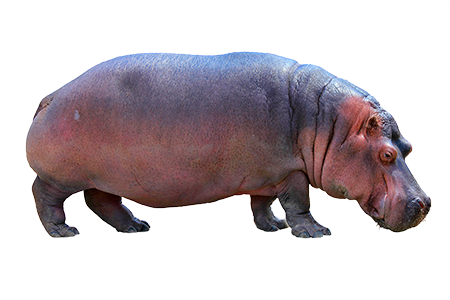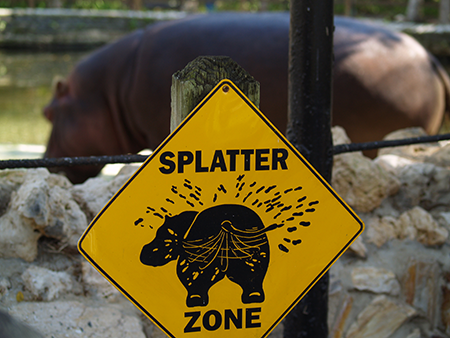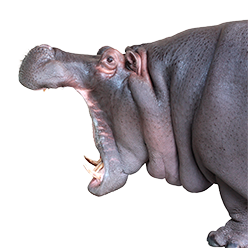The Hippopotamus
The Hippopotamus

Not many animals have a name as fun to say as “hippopotamus.” (“I want a hippopotamus for Christmas” sounds a lot more entertaining than “I want a dog, a goat, or a cat for Christmas.”) The name hippopotamus means “river horse” (but, of course, they aren’t horses). “Hippopotamus” comes from two Greek words: potamos, meaning “river,” and hippos, meaning “horse” (the order of which makes you wonder why the animal is not called potamushippo). For whatever reason, the name hippopotamus (or “hippo” for short) stuck. And hippopotami (a plural form for hippopotamus) have captivated people for thousands of years…and for good reasons.
First, hippos simply have a cute and funny look about them—kind of like a silly-looking pot-bellied-pig, but (literally) tons bigger. We may not normally think of huge, nearly hairless animals as cute, but hippos look like 4,000 pounds of hilarious, loveable, huggable chubbiness. Their long, barrel-shaped, massive pot-bellies are carried about on short, stubby legs. The largest hippos can reach lengths of 16 feet, weigh more than 9,000 pounds, and grow over five feet tall (at the shoulder). In other words, your little car or boat is no match for a huge hippopotamus.

With such big, blubbery bodies and short legs, you might not think hippos could run very fast, but in reality, they can “move it.” Hippos
can trot on their stumpy legs at 18 miles per hour over short distances. When angry, they can reach even higher speeds, outrunning most humans.
A Territorial Tail to Tell
Unlike the longer, slender tails of ele-phants and giraffes, hippos have short, fat, triangle-like tails, which they use in an effective (but really gross) manner (seemingly without any “manners” whatsoever). In order to mark their territory, they move their tails at the same time they drop their droppings. They don’t just move their tails; they wag and spin them at a super-fast speed (which sounds like a playing card stuck in the spokes of a moving bicycle)…propelling their dung in all directions. (Needless to say, when you see a hippo at the zoo, you might want to stand back—way back—since you never know when they will feel the need to mark their territory.)


Designed for Life in the Water
Hippos love the water. As long as lakes, rivers, and swamps are around, that’s where they spend most of their time. Female hippos (called cows) even give birth underwater.
You may not know it, but hippos do not actually swim. Unlike most mammals, they cannot even float. They sink down into the water, trot along the bottom, and push back up for air. (Running on the bottom of lakes and rivers sounds pretty fun, doesn’t it?!)




Amazingly, hippos often sleep underwater. God designed them with what scientists call a “subconscious reflex,” which causes them to “automatically” push themselves up to the surface for air (at least) every five minutes.
Have you ever done a “cannonball” in a pool or a river and not held your nose? (I don’t recommend it.) That shot of water up your nose can sting, take your breath away, make you cough, and cause you to have a runny nose afterward. Sometimes you can get excess water in one or both ears, which can cause discomfort, infection, and can make your hearing kind of muffled.
Hippos do not concern themselves with getting water up their nostrils or in their ears. As creatures that live much of their lives in water, God equipped them with the ability to shut their nostrils and press their ears against their heads when going under water in order to keep out most all of the water. What little water that might seep in, they quickly and forcefully expel from their nostrils and vigorously wiggle out of their ears upon resurfacing.
It is also helpful to hippos that God created their nostrils, eyes, and ears on top of their heads. This perfect design allows them to submerge all of their bodies except the very tops of their heads when standing in water that’s not too deep. Their water-loving bodies stay moist and hydrated, while the beast can remain on high alert (seeing, hearing, and smelling all around) day after day and year after year. By the way, hippos often live between 40 and 50 years!
A Massive Mouth

Do not let a hippo’s seeming adorableness deceive you. This animal is actually one of the most dangerous creatures on the planet. It’s not that they’re “hungry, hungry hippos”; they’re just very territorial animals, especially in the water. Every year in Africa, hundreds of people (who dare to get too close to hippos) wind up losing their lives. A person is more likely to die in a run-in with a hippo than even a lion. (Yes, hippos kill more people every year than lions.) Hippos are known to ram and capsize boats, killing various ones who fall into the water.
Truly, one of the last places you would ever want to find yourself is in the jaws of a hippo. Though they are herbivores (eating a variety of vegetation), that does not stop them from using their massive mouths and foot-long teeth to chomp down on nearly any animal or human that enters their territory. Hippos are so fearless they will even chomp down on crocodiles.
A hippo’s bite has been measured at 1,800 psi (pounds per square inch). God gave this creature a massive mouth that it can open 150 degrees wide (about 4 to 5 feet) and then bite down with literal bone-crushing force. Neither lions nor crocodiles are any match for the jaws of this creature.





One Cool Skin-Ointment Factory
If you lived in the blistering heat of East Africa and were out in the Sun for very long, you would likely need a lot of Sunscreen to moisturize and protect your skin. You would also want to take along some antibiotic (such as Neosporin®) so that if your skin cracks or you get a cut, you can properly treat your wound. (Washing a wound in the dirty water in which hippos live would only worsen things.)
What do hairless hippos (at least mostly hairless) do to survive the hot African climate when they cannot find much water? How does their bare skin not crack, peel, blister, bleed, and become infected during intense Sun exposure? And when they do find water, how do any flesh wounds (perhaps from fighting) not get infected in bacteria-infested waters?
Amazingly, God made these creatures with their very own moisturizing, antiseptic “skin-ointment factories.” We’re not talking about merely sweating salty water, which is cool enough (and literally cools us off). Hippos produce and secrete a thick, oily fluid from (what one scientist called) “special glands in their skin.”1 The fluid is not mere sweat; neither is it blood (even though some used to think so since it turns red, and later brown, on the skin of hippos). The fluid functions as “an automatic skin ointment.”2 The Neosporin-like fluid helps kill any harmful bacteria on the skin.3 It even “protects the skin from becoming waterlogged when a hippo is in the water.”4
If evolution is true, how did a hippo (or the alleged ancestor of the hippo) ever go from being unable to produce such a phenomenal fluid…to making it? Does an animal just “will” such a thing to happen? Could you, if you wanted to produce such a substance? Of course, not. The idea that hippos evolved this unique ability or any other does not make sense. Complex, functional design like that found in the hippo demands an amazing Designer!


Endnotes
1 Mark Ritchie (2002), “Do Hippopotamuses Actually Have Pink Sweat? Scientific American, May 6, https://www.scientificamerican.com/article/do-hippopotamuses-actuall/.
2 Ritchie.
3 Yoko Saikawa, et al. (2004), “The Red Sweat of the Hippopotamus,” Nature, 429:363, May 27, https://www.nature.com/articles/429363a.
4 Ritchie.

REPRODUCTION & DISCLAIMERS: We are happy to grant permission for this article to be reproduced in part or in its entirety, as long as our stipulations are observed.










0 Comments:
Post a Comment
<< Home